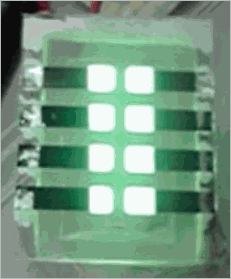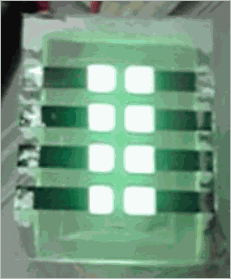Japanese Researchers Double Green Phosphorescent OLED Efficiency
A Japanese research group succeeded in making an OLED device using a green light-emitting phosphor material and achieving a very high light-emitting efficiency of 210lm/W.
The research group, which is led by professor Akiyoshi Mikami of the Advanced Optical Electro Magnetic Field Science Lab, the Kanazawa Institute of Technology, boosted the light-extraction efficiency to 56.9%, more than twice that of existing OLED devices. The group made this announcement at the JSAP (Japan Society of Applied Physics) 56th Spring Meeting, 2009, which took place at Tsukuba University in Japan, from March 30 to April 2, 2009.
It has been regarded as a big challenge for OLED devices to enhance their low light-extraction efficiency of slightly less than 30%. Using the new technology, it is possible that the light-emitting efficiencies of OLED displays and lamps will sharply increase.
The OLED device developed by the research group has the bottom emission type structure, which extracts light through a substrate made with transparent electrodes. In addition, a 0.7mm-thick glass plate with a refraction index as high as 2.03 is bonded to the substrate. The surface of this glass plate is processed to have a structure of about 0.3mm-pitch optical lens array.
The material for the device's light-emitting layer is a host material called "CBP" added with an iridium complex, "Ir(ppy)3." Its light emission peak lies in the range of wavelengths between 500 and 550nm, which corresponds to green color.
When emitting light at a luminance of 10cd/m2, it has a light-emitting efficiency of 210lm/W and a light-extraction efficiency of 56.9%. On the other hand, when emitting light without the high-refractive glass plate, its light-emitting efficiency is only 94.3lm/W. This means the glass plate boosted the light-extraction efficiency by 2.3 times.
Developed through detailed theoretical analysis
The research group made the achievement by developing "FROLED" software that theoretically calculates optical behaviors, and by "conducting a detailed analysis on light-extraction efficiency for the first time in Japan" Mikami said.
The glass plate results in higher light-extraction efficiency because "the high-refractive glass plate strongly attracts the optical energy, which usually remains inside the thin film and the substrate of an OLED at a ratio of about 1:1, to the side of the substrate," Mikami said. And the lens array structure formed on the surface of the glass plate enables to extract light that is otherwise trapped in the substrate and the glass plate, he said.
"The light-extraction efficiency is theoretically calculated to be 75%, which is three times higher than before," Mikami said. "We might be able to realize it by improving the device manufacturing technology."


